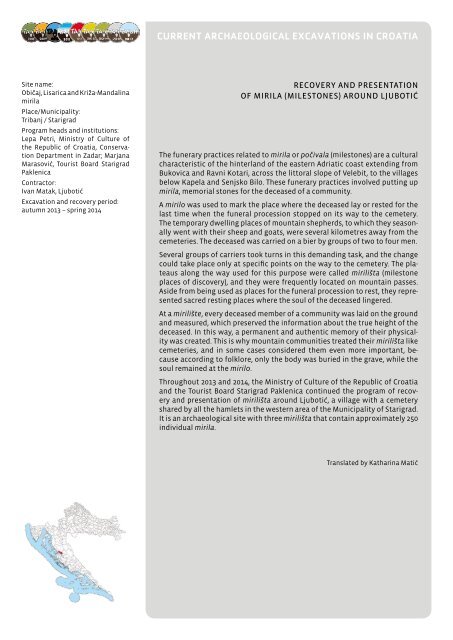AMZ_TAIUH_2017_ prijevodi na engleski
Create successful ePaper yourself
Turn your PDF publications into a flip-book with our unique Google optimized e-Paper software.
CURRENT ARCHAEOLOGICAL EXCAVATIONS IN CROATIA<br />
Site <strong>na</strong>me:<br />
Običaj, Lisarica and Križa-Mandali<strong>na</strong><br />
mirila<br />
Place/Municipality:<br />
Tribanj / Starigrad<br />
Program heads and institutions:<br />
Lepa Petri, Ministry of Culture of<br />
the Republic of Croatia, Conservation<br />
Department in Zadar; Marja<strong>na</strong><br />
Marasović, Tourist Board Starigrad<br />
Paklenica<br />
Contractor:<br />
Ivan Matak, Ljubotić<br />
Excavation and recovery period:<br />
autumn 2013 – spring 2014<br />
RECOVERY AND PRESENTATION<br />
OF MIRILA (MILESTONES) AROUND LJUBOTIĆ<br />
The funerary practices related to mirila or počivala (milestones) are a cultural<br />
characteristic of the hinterland of the eastern Adriatic coast extending from<br />
Bukovica and Ravni Kotari, across the littoral slope of Velebit, to the villages<br />
below Kapela and Senjsko Bilo. These funerary practices involved putting up<br />
mirila, memorial stones for the deceased of a community.<br />
A mirilo was used to mark the place where the deceased lay or rested for the<br />
last time when the funeral procession stopped on its way to the cemetery.<br />
The temporary dwelling places of mountain shepherds, to which they seaso<strong>na</strong>lly<br />
went with their sheep and goats, were several kilometres away from the<br />
cemeteries. The deceased was carried on a bier by groups of two to four men.<br />
Several groups of carriers took turns in this demanding task, and the change<br />
could take place only at specific points on the way to the cemetery. The plateaus<br />
along the way used for this purpose were called mirilišta (milestone<br />
places of discovery), and they were frequently located on mountain passes.<br />
Aside from being used as places for the funeral procession to rest, they represented<br />
sacred resting places where the soul of the deceased lingered.<br />
At a mirilište, every deceased member of a community was laid on the ground<br />
and measured, which preserved the information about the true height of the<br />
deceased. In this way, a permanent and authentic memory of their physicality<br />
was created. This is why mountain communities treated their mirilišta like<br />
cemeteries, and in some cases considered them even more important, because<br />
according to folklore, only the body was buried in the grave, while the<br />
soul remained at the mirilo.<br />
Throughout 2013 and 2014, the Ministry of Culture of the Republic of Croatia<br />
and the Tourist Board Starigrad Paklenica continued the program of recovery<br />
and presentation of mirilišta around Ljubotić, a village with a cemetery<br />
shared by all the hamlets in the western area of the Municipality of Starigrad.<br />
It is an archaeological site with three mirilišta that contain approximately 250<br />
individual mirila.<br />
Translated by Kathari<strong>na</strong> Matić


